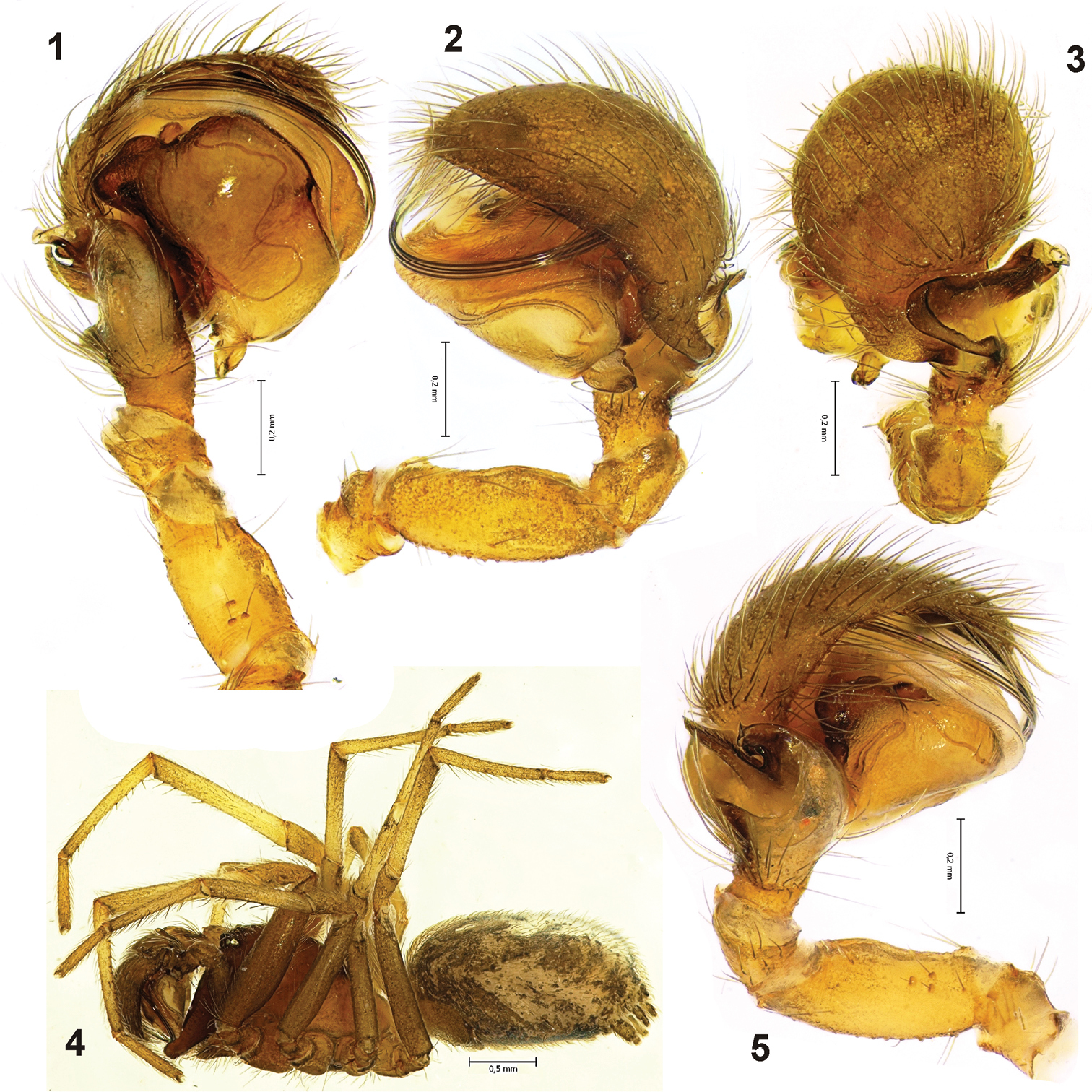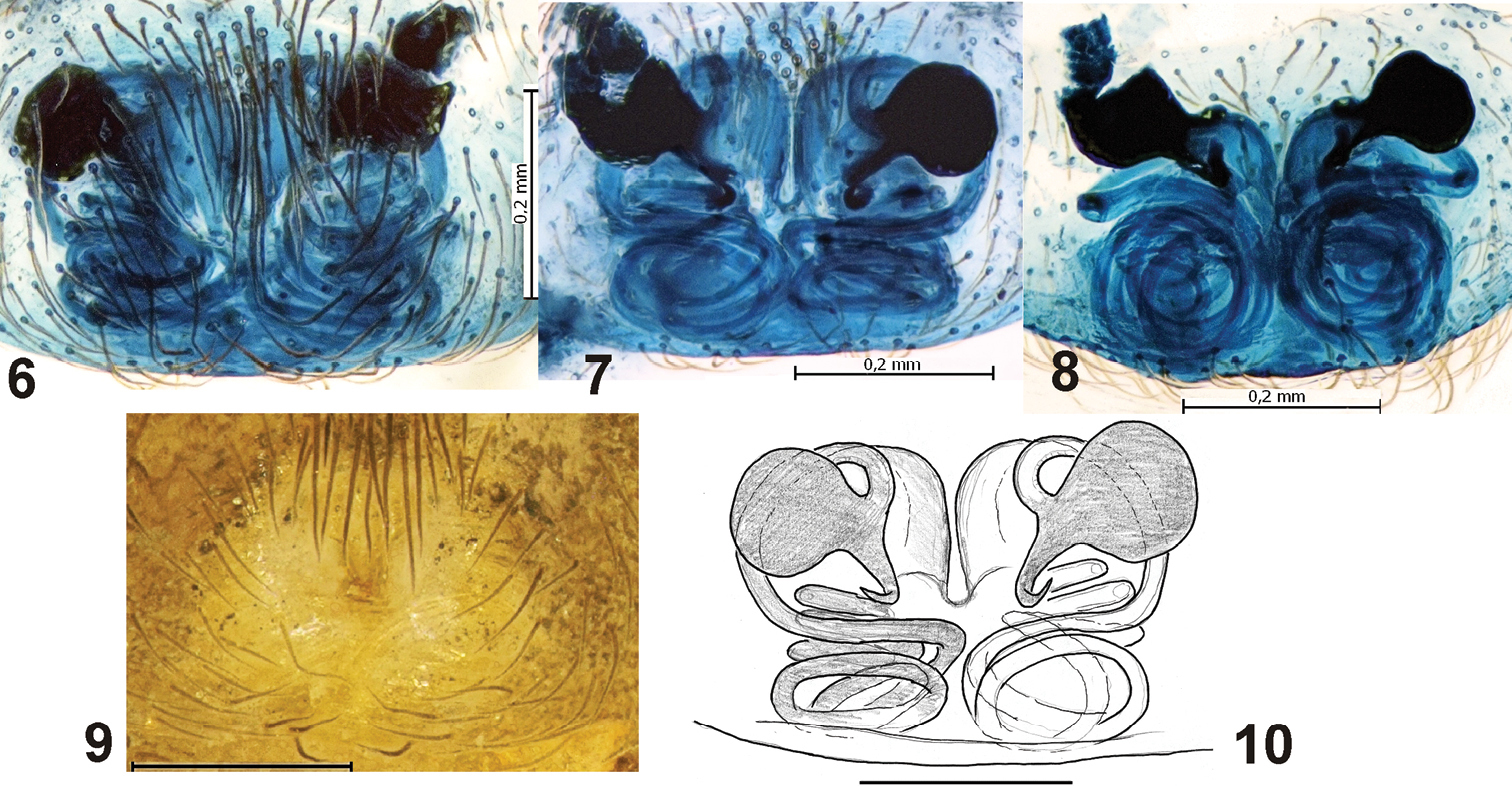






(C) 2011 Mikhail M. Omelko. This is an open access article distributed under the terms of the Creative Commons Attribution License, which permits unrestricted use, distribution, and reproduction in any medium, provided the original author and source are credited.
For reference, use of the paginated PDF or printed version of this article is recommended.
A poorly known spiders species, Titanoeca lehtineni Fet, 1986, from southwestern Central Asia is redescribed and diagnosed.
Titanoeca, Turkmenistan, redescription, spider
Titanoeca lehtineni was described on the basis of 92♂ and 4♀ specimens from seven localities collected in south Turkmenistan (
Specimens were photographed using an Olympus Camedia E-520 camera attached to an Olympus SZX16 stereomicroscope at the Zoological Museum, University of Turku. Photographs were taken in dishes with paraffin on the bottom. Images were montaged using “CombineZP” image stacking software. Different sized holes were made in the paraffin to keep the specimens in the correct position. All measurements are in mm. The label is spelled like in the original, although some names and administrative units names have changed. Specimens are deposited in the Zoological Museum of the Moscow State University (ZMMU) and in the Siberian Zoological Museum (SZM) in Novosibirsk.
Taxonomyhttp://species-id.net/wiki/Titanoeca_lehtineni
Figs 1-10TURKMENISTAN: 2♂ 16♀ (ZMMU), Mary Area, Kushka (now = Serhetabad) Distr., ca 18 km S of Kyzyldzhar kordon (=field station), ca 1 km ESE of Eroilanduz Salt Lake, 375 m, 35°39'40"N, 61°50'13"E, 7.04.2002 (A.V.Gromov); 1♂ (SZM), Kopetdagh Reserve, Kalinskiy Zakaznik, 18.05.1987 (V.Dubatolov).
According to the original description the types were deposited in the Zoological Institute in Sankt Petersburg (ZISP) and in the Zoological Museum of the Moscow State University (ZMMU). Paratypes in ZMMU were not found (Mikhailov, personal communication) and were not searched for in ZISP. I am sure about the current identification because the material studied was collected from within the same area that the type series originated.
This species can be easily recognized from all other congeners and even all species of Titanoecidae by its very long embolus which forms several coils (Figs 2, 5), and the weakly sclerotized epigyne (Fig. 9) with extremely long insemination ducts (Figs 6–8, 10).
Total length (♂/♀) 3.25–3.5/3.5–4.6. Carapace: 1.45/1.68 long, 1.13/1.23 wide. Males (Fig. 4) and females uniformly brown, without any pattern. Tibiae and metatarsi in male with ventral spines (Fig. 4).
Palp as in Figs 1–3, 5. Femur shorter than cymbial length and even shorter than tegulum (Fig. 2). Tibial apophysis large on dorsal and prolateral sides. Tegulum wider than long (Fig. 1), embolus well visible in ventral, pro- and retrolateral views.
Epigyne as in Figs 6-10. Epigyne is weakly sclerotized and has no distinct margins. It is also lighter than other parts of the abdomen. Therefore, the adult female could easily be mistaken for a juvenile specimen. Vulva complicated, with relatively small round receptacula in the anterior part, long insemination ducts forming at least seven coils and strongly sclerotized fertilization ducts.
The specimens examined are slightly smaller than the specimen measured by
This species has exceptionally long insemination ducts compared to other species in this family. They appear to correspond to the very long embolus in the male. Insemination ducts in Titanoeca lehtineni are longer than in Nurscia sequerai (Simon, 1892) (cf. fig. 6 in
So far this species is known from southern and southwestern Turkmenistan and southwest Kazakhstan. Its occurrence in western Uzbekistan and northeastern Iran is highly likely.
Male of Titanoeca lehtineni. 1 palp, ventral 2 palp, retrolateral 3 palp, dorsal 4 habitus, lateral 5 palp, prolateral.
Epigyne of Titanoeca lehtineni. 6, 9 ventral view 7, 10 dorsal view 8 caudal view. 6–8, 10 after maceration. Left receptaculum was broken during maceration.
Length of leg segments in male and female (♂/♀)
| Femur | Patella | Tibia | Metatarsus | Tarsus | Total | |
| I | 1.35/1.33 | 0.52/0.60 | 1.17/0.95 | 1.05/0.90 | 0.58/0.55 | 4.67/4.33 |
| II | 1.13/1.13 | 0.43/0.50 | 0.83/0.75 | 0.85/0.75 | 0.50/0.50 | 3.74/3.63 |
| III | 0.97/1.05 | 0.38/0.45 | 0.70/0.65 | 0.73/0.76 | 0.48/0.40 | 3.26/3.31 |
| IV | 1.17/1.25 | 0.43/0.53 | 0.97/1.0 | 0.88/0.87 | 0.45/0.43 | 3.90/4.08 |
I wish to thank Yuri M. Marusik (Magadan, Russia) who allowed me to study and redescribe specimens of this species, Seppo Koponen (Turku, Finland) for access to digital equipment in the Zoological Museum, University of Turku and Kirill G. Mikhailov (Zoological Museum of the Moscow State University) who searched for paratypes in the museum collections. The English of an early draft was kindly checked by David Penney (Manchester). This work was supported in part by the Russian Foundation for Basic Research (grant № 11–0401716).

